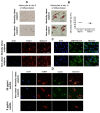Oxidized LDL Modify the Human Adipocyte Phenotype to an Insulin Resistant, Proinflamatory and Proapoptotic Profile
- PMID: 32244787
- PMCID: PMC7226150
- DOI: 10.3390/biom10040534
Oxidized LDL Modify the Human Adipocyte Phenotype to an Insulin Resistant, Proinflamatory and Proapoptotic Profile
Abstract
Little information exists in humans on the regulation that oxidized low-density lipoprotein (oxLDL) exerts on adipocyte metabolism, which is associated with obesity and type 2 diabetes. The aim was to analyze the oxLDL effects on adipocytokine secretion and scavenger receptors (SRs) and cell death markers in human visceral adipocytes. Human differentiated adipocytes from visceral adipose tissue from non-obese and morbidly obese subjects were incubated with increasing oxLDL concentrations. mRNA expression of SRs, markers of apoptosis and autophagy, secretion of adipocytokines, and glucose uptake were analyzed. In non-obese and in morbidly obese subjects, oxLDL produced a decrease in insulin-induced glucose uptake, a significant dose-dependent increase in tumor necrosis factor-α (TNF-α), IL-6, and adiponectin secretion, and a decrease in leptin secretion. OxLDL produced a significant increase of Lox-1 and a decrease in Cxcl16 and Cl-p1 expression. The expression of Bnip3 (marker of apoptosis, necrosis and autophagy) was significantly increased and Bcl2 (antiapoptotic marker) was decreased. OxLDL could sensitize adipocytes to a lower insulin-induced glucose uptake, a more proinflammatory phenotype, and could modify the gene expression involved in apoptosis, autophagy, necrosis, and mitophagy. OxLDL can upregulate Lox-1, and this could lead to a possible amplification of proinflammatory and proapoptotic effects of oxLDL.
Keywords: adipocyte; apoptosis; inflammation; oxidized low-density lipoprotein; scavenger receptors.
Conflict of interest statement
The authors declare that they have no conflict of interest.
Figures








Similar articles
-
Oxidized LDL Increase the Proinflammatory Profile of Human Visceral Adipocytes Produced by Hypoxia.Biomedicines. 2021 Nov 18;9(11):1715. doi: 10.3390/biomedicines9111715. Biomedicines. 2021. PMID: 34829944 Free PMC article.
-
Lectin-like oxidized low-density lipoprotein receptor-1-mediated autophagy in human granulosa cells as an alternative of programmed cell death.Endocrinology. 2006 Aug;147(8):3851-60. doi: 10.1210/en.2006-0088. Epub 2006 May 11. Endocrinology. 2006. PMID: 16690797
-
PPARgamma regulates adipocyte cholesterol metabolism via oxidized LDL receptor 1.J Clin Invest. 2005 Aug;115(8):2244-56. doi: 10.1172/JCI24130. Epub 2005 Jul 7. J Clin Invest. 2005. PMID: 16007265 Free PMC article.
-
Dual effects of oxidized low-density lipoprotein on LXR-ABCA1-apoA-I pathway in 3T3-L1 cells.Int J Cardiol. 2008 Aug 1;128(1):42-7. doi: 10.1016/j.ijcard.2007.05.017. Epub 2007 Jul 23. Int J Cardiol. 2008. PMID: 17643522
-
Oxidized HDL is a potent inducer of adipogenesis and causes activation of the Ang-II and 20-HETE systems in human obese females.Prostaglandins Other Lipid Mediat. 2016 Mar;123:68-77. doi: 10.1016/j.prostaglandins.2016.04.004. Epub 2016 May 11. Prostaglandins Other Lipid Mediat. 2016. PMID: 27179555 Review.
Cited by
-
Oxidized LDL Increase the Proinflammatory Profile of Human Visceral Adipocytes Produced by Hypoxia.Biomedicines. 2021 Nov 18;9(11):1715. doi: 10.3390/biomedicines9111715. Biomedicines. 2021. PMID: 34829944 Free PMC article.
-
Effects of oxidized LDL versus IL-1ß/TNF-ɑ/INFɣ on human gingival mesenchymal stem cells properties.J Periodontal Res. 2025 Jan;60(1):77-89. doi: 10.1111/jre.13319. Epub 2024 Jul 2. J Periodontal Res. 2025. PMID: 38952262 Free PMC article.
-
LDL/HDL cholesterol ratio is associated with new-onset NAFLD in Chinese non-obese people with normal lipids: a 5-year longitudinal cohort study.Lipids Health Dis. 2021 Mar 25;20(1):28. doi: 10.1186/s12944-021-01457-1. Lipids Health Dis. 2021. PMID: 33766067 Free PMC article.
-
Cytotoxicity, Antiadipogenic, Low-Density Lipoprotein Oxidation Inhibitory Activities, and Acute Toxicity Study of Psychotria densinervia Hydroethanolic Leaf and Bark Extracts.ScientificWorldJournal. 2024 Dec 17;2024:1732653. doi: 10.1155/tswj/1732653. eCollection 2024. ScientificWorldJournal. 2024. PMID: 39720344 Free PMC article.
-
Subcutaneous adipose tissue gene transcripts associated with progressive myosteatosis in persons with HIV.AIDS. 2025 Oct 1;39(12):1739-1748. doi: 10.1097/QAD.0000000000004264. Epub 2025 Jun 11. AIDS. 2025. PMID: 40528404
References
-
- Holvoet P., Jenny N.S., Schreiner P.J., Tracy R.P., Jacobs D.R. The relationship between oxidized LDL and other cardiovascular risk factors and subclinical CVD in different ethnic groups: The Multi-Ethnic Study of Atherosclerosis (MESA) Atherosclerosis. 2007;194:245–252. doi: 10.1016/j.atherosclerosis.2006.08.002. - DOI - PubMed
Publication types
MeSH terms
Substances
Grants and funding
LinkOut - more resources
Full Text Sources

